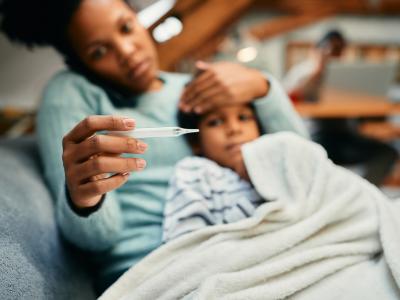Trial of rapid respiratory tests finds no reduction in antibiotics
The use of rapid respiratory pathogen (RRP) testing among children with influenza-like illness (ILI) did not reduce antibiotic prescribing, according to a randomized clinical trial published late last week in JAMA Network Open.
The single-center trial, conducted by investigators with the University of Colorado School of Medicine and Children's Hospital Colorado, involved children aged 1 month to 18 years who presented to the emergency department with ILI from Dec 1, 2018, to Nov 30, 2019. All children received a nasopharyngeal swab for RRP testing and were randomized 1:1 to an intervention group, in which the emergency department (ED) clinician and families of children received test results, and a control group that did not. The primary outcome was antibiotic prescribing during the ED visit. Secondary outcomes included antiviral prescribing, ED length of stay, and hospital admission.
The cohort consisted of 908 children, with 452 in the intervention group and 456 in the control group. The median age was 2.1 years, and there were no significant differences in demographic and clinical characteristics between the two groups. Positive RRP test results were obtained for 795 of 931 visits (85%). The most common pathogens were enterovirus (n=295), influenza (180), respiratory syncytial virus (162), and adenovirus (115).
In the intention-to-treat (ITT) intervention group, children were more likely to receive antibiotics (relative risk [RR], 1.3; 95% confidence interval [CI], 1.0 to 1.7), with no significant differences in antiviral prescribing, medical visits, and hospitalization. In a modified ITT analysis, children whose clinician knew the RRP test results were more likely to receive antivirals (RR, 2.6; 95% CI, 1.6 to 4.5) and be hospitalized (RR, 1.8; 95% CI, 1.4 to 2.5) than those whose clinicians did not know the test results, but antibiotic prescribing was not significantly different (RR, 1.1; 95% 0.9 to 1.4).
"The results of this randomized clinical trial show that RRP testing for children with acute respiratory illnesses in an ED setting did not lead to a decrease in antibiotic prescribing," the study authors wrote. "The greatest effect on clinicians' clinical decision-making was appropriate antiviral use for children based on influenza test results, supporting the potential benefit for rapid molecular influenza testing in this setting."
Jun 4 JAMA Netw Open study
WHO formally recommends Johnson & Johnson's Ebola vaccine
The Strategic Advisory Group of Experts (SAGE) on Immunization for the World Health Organization (WHO) formally supports the use of Johnson & Johnson's two-dose Ebola vaccine regimen, Zabdeno (Ad26.ZEBOV) and Mvabea (MVA-BN-Filo), both during outbreaks for individuals at risk for Ebola exposure and before outbreaks for first responders, according to a press release today from Johnson & Johnson.
"Our vision is to stop Ebola outbreaks before they start," Johnson & Johnson said in the release. "Johnson & Johnson accelerated the development of an Ebola vaccine during the 2014 Ebola crisis. Since then, we have sponsored 15 clinical trials across three continents that have demonstrated the regimen to be safe and capable of inducing an immune response."
The announcement comes on the heels of the WHO prequalification of the vaccines in April. The vaccines were developed following the 2014-2016 West African Ebola outbreak and have been used in Rwanda and the Democratic Republic of the Congo since 2018 on an emergency basis during outbreaks in both countries.
Johnson & Johnson said it is now focused on securing national registrations for the vaccine in Ebola-affected countries in Africa. To date, more than 235,000 people have received at least the first dose of the Ebola vaccine, including 190,000 who have been fully vaccinated with both doses.
Jun 4 Johnson & Johnson statement














